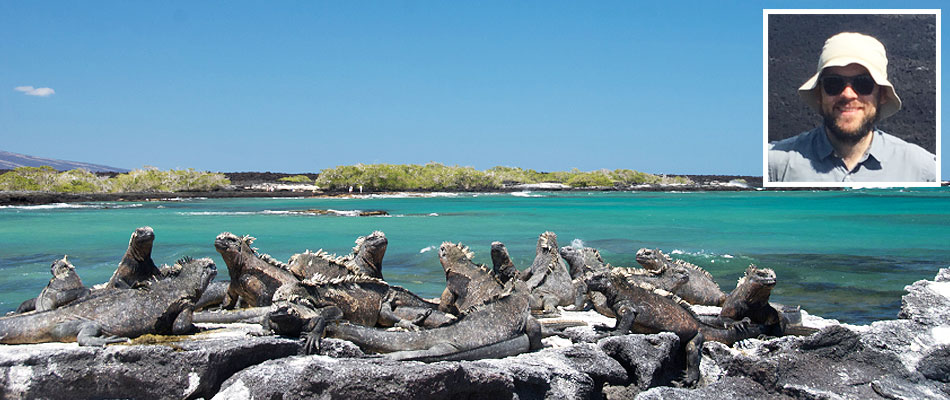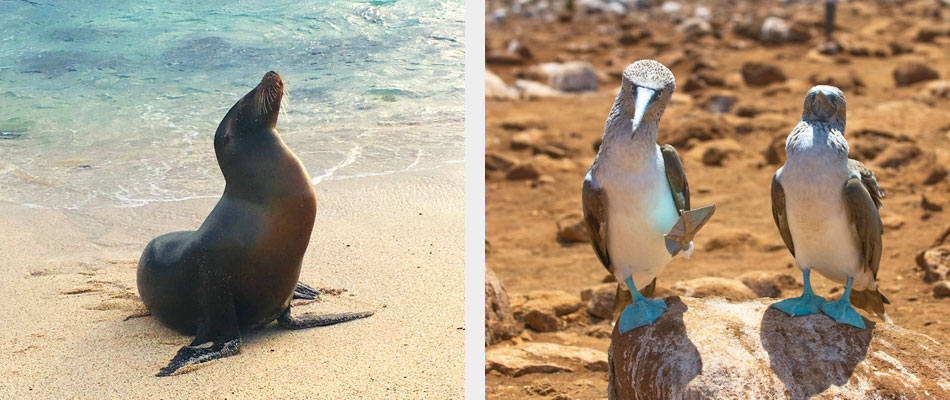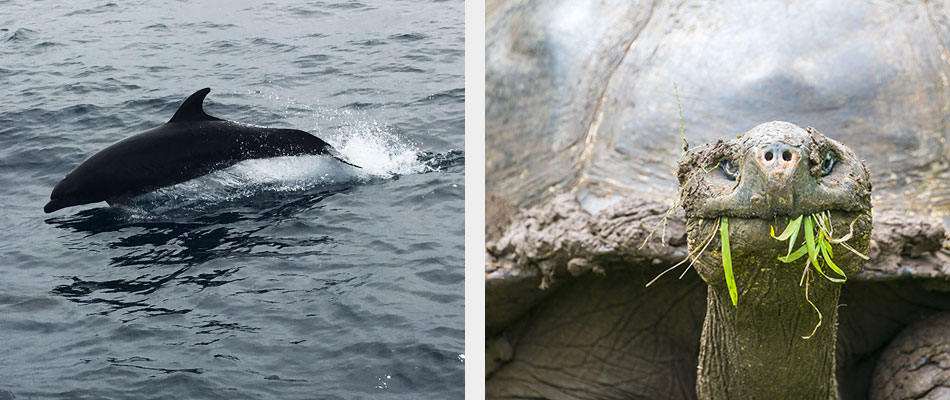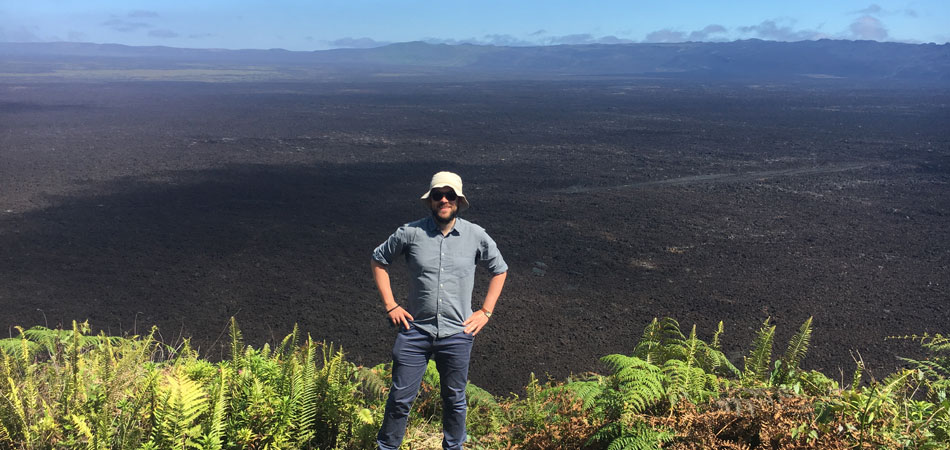Traveler interview: Martin White - Galapagos land based small group adventure vacation

Marine Iguanas & Martin White inset.
What made you want to go to the Galapagos Islands?
I am taking an eight-month sabbatical from work and wanted to see more of South America; I particularly wanted to go to Machu Picchu and Peru so I was thinking about what else I could do. I had never even thought about going to the Galapagos. You see it on TV and nature shows, but Iíd never considered going. Then I looked into it and found the tour. Iíd never done wildlife focussed travel before, I had always been to see cities and culture. I thought it would be interesting to do something completely different. Looking at the Galapagos, itís the sort of place where you have to do a tour of some sort, even if itís just getting there and then getting on a boat with someone. Itís difficult to do it independently.
What is the most useful thing you packed?
My seasickness tablets. Thereís quite a lot of travel between the islands by boat. Iíd never done anything beyond a cross channel ferry before, but some of the trips in the Galapagos can take two and a half hours on a speedboat. I get quite bad motion sickness so even sitting on the top in the fresh air it could get nasty; fortunately I just avoided it, but I even saw some locals struggling. Some people also brought medication for altitude. Quito is really high, not as bad as Cuzco in Peru, but you do feel it. If you go on the TelefťriQo [a gondola lift from the city center up the east side of Pichincha Volcano] thatís over 4,000m. I found the thing that was good was just drinking lots of water.
Was there anything you could have left behind?
The weather is variable, so I needed everything I took Ė my jumper and waterproof as well as shorts and sandals. They donít have four seasons in the Galapagos; itís just wet and dry. I went in the dry season, in July, but itís not a tropical place, as you might expect from islands on the equator. Itís not like the Caribbean. It could be quite overcast then the clouds would drift away and youíd have quite sunny days, some rain, not boiling hot but warm. Actually, quite similar to the weather weíve got here!
Did you learn or use any Spanish?
I know a little. I had been practising on Duolingo online for a year, partly because I thought I might go to South America and partly because I thought it might be nice to learn something, and it was quite useful. Iím not very good, but I had decent restaurant Spanish. With hand signals, I had a couple of conversations, one with a guy in the town square in Quito, he was interested in the film camera I had. Most of the other people I was with had had the same idea, but had only started learning two weeks before they left. They were very impressed. They thought I was some sort of fluent Spanish speaker. I could ask for a table for five and things like that!
What is your favourite souvenir/present?
The Galapagos is famous for its nature and thatís one of the things you canít bring back, of course; itís not famous for its textiles or anything. The main thing I brought back is a little knitted blue-footed booby, itís cute. Itís a gift for me, so itís on my shelf!

Sea lion and blue footed booby. [Sea lion photo by Martin White]
Were your preconceptions very different from reality?
There are more people there than you expect. On the nature documentaries, you think itís going to be this pristine piece of nature where you might just see a couple of scientists. Itís not quite that. Inevitably, if youíre doing a land-based tour like I did you have to stay in a hotel in a small town somewhere, and some places feel a bit more developed than others. I didnít expect to see agricultural areas and farmland, either.
On the flip side, there are huge bits of the islands where thereís nothing in terms of human development. But you donít necessarily get to see that and thatís why itís pristine, because there are no people there. Perhaps on a boat tour you can get to some of the more uninhabited places. When we got on little boats to go snorkelling there were just a few other people doing the same.
The other thing I didnít expect is that the individual islands feel quite different. Santa Cruz, for example, is the most developed island. The town feels like a tourist resort, with lots of shops selling souvenir T-shirts, lots of retired Americans on tour. I think itís the place where people just fly in and out of and stay just on that island, or in their boats, so it feels quite busy. But then Isabela, which is the biggest in area but has the third highest population, feels like a very sleepy small town. Thereís a big beach with half a dozen bars where you can chill out. That feels very different. Then youíve got Floreana which has 100 people on it and feels like the end of the earth and middle of nowhere.
There are big islands with no one on them, apart from some giant tortoises, too. So, depending on which island you go to the feel is quite different. I thought the whole place would feel like youíre on the Galapagos, but itís not quite that. If you stayed on just one island youíd have a very different experience to touring around.
What did you think was going to be hard that turned about to be OK?
The organisation was super easy, because I was on a tour. There are different charges Ė youíve got to buy special transit cards when you fly from Quito to the Galapagos, got to pay entry fee when you go into the Galapagos, got to pay a port fee on one of the islandsÖ All that sort of thing was taken care of. We were told what to do and when to do it so we didnít have to worry about that. The tour took care of all that hassle.
I hadnít been snorkelling for about 10 years, so I was a bit nervous about how I would do, and just dealing with being in the ocean. But actually, the guide was really good at explaining where you were going to swim, the limits of where you could go, there was always a leader at the front pointing things out, someone at the back so no one got lost, and they also had buoyancy rings if anyone got into trouble. The sea was never that rough, but there were quite strong currents. So, if the currents were against you and you were swimming hard, you might not move that much. If youíre a weak swimmer, this could panic you. There was also quite a lot of snorkelling, so if you didnít like swimming you werenít going to enjoy this trip.
Do you have any sense memories from your trip, other than Ďsightí ones?
I definitely remember the smells of the sea lions everywhere! The first day we walked from the hotel into the town and two minutes in we saw a group of sea lions. We walked up and took photos and the guide told us all about them. We were all really keen on this! By the next day we were all completely blasť, there were hundreds everywhere. You stop even noticing them. You smell them before you notice them. They have that combination of rotten fish and seaside fishing village smell, coupled with the smell of cow, as well, a faint smell of dung! They look cute, but they do pong a bit.
Was there one person that you met whom you will always remember?
Everyone on the tour was very fun and friendly. We were a group of 10 with eight Australians, a Brit (me) and a German. Doing a nature tour, you donít meet many locals, but our leader Jessica was really good because she was knowledgeable about the animals we were seeing and also brilliant at organisation, and chatting to us about her life. She was Ecuadorian, brought up on one of the Galapagos Islands, so it was really good to learn what lifeís like for someone who lives there.

Dolphin and Giant tortoise. [Dolphin photo by Martin white, Giant tortoise photo by Alberto Loyo ]
What was your favourite wildlife sighting?
I think maybe when we saw the bottlenose dolphins. We werenít out looking for dolphins. I was sat on top of the boat because I get seasick and I saw one in the distance and the driver went towards it, then they all started playing with the boat, jumping in front of the bow and flipping into the air. I had never seen dolphins in the wild before so that was really cool, and I didnít really expect to see them because you donít think of dolphins when you think of the Galapagos Islands. That was going to Floreana, then on the way back we saw a sei whale. You could see it come up for air then see the shape of it under the water. Then it would dive really deep and its tail would flip up. It was only 30m or 40m from our boat.
The giant tortoises seemed a bit unreal, especially the way they move. They seem animatronic. We first saw them in a breeding center then seeing them in the wild was even better Ė very weird creatures! And the iguanas as well, when you first see them, theyíre pretty ugly, they spit out saltwater, so theyíre like kind of aggressive punk rockers, black, spikes all down their back, and they just gob at you! A couple of times they would swim next to us when we were snorkelling, which was very cool. There are loads of finches as well. Itís fun trying to keep your eye on them, to figure out why the beak is different on this finch compared to the finches on the other islands.
Was anything underrated, in that it was a pleasant surprise?
Just seeing the landscape actually. On Isabela, we hiked up to a volcano. We didnít really see any nature in terms of interesting animals, but we went up to the caldera, which is 10km across, a huge thing. That was amazing, seeing all the lava fields. At that height, the landscape was much better than Iíd imagined.
Has this trip influenced where you would like to go next?
This is the first organised small group tour Iíve been on and it encouraged me to do that again, especially if itís Iíd be by myself otherwise. This was also the first time Iíve done a nature focussed vacation, and Iíd like to do something like that again.

Martin at Sierra Negro volcano, Isabela Island. [Photo from Martin White]
Find out more about this trip
Continue reading about this Galapagos land based small group adventure




